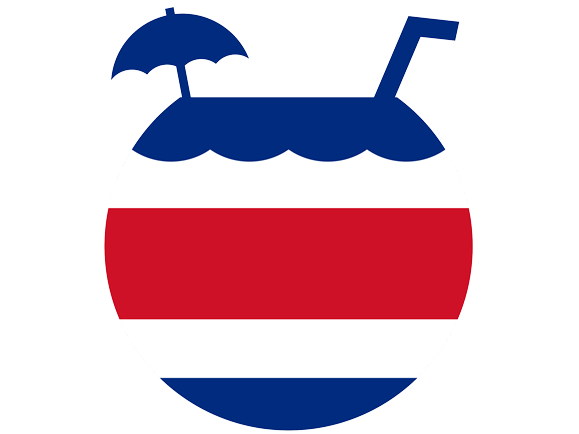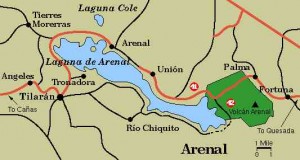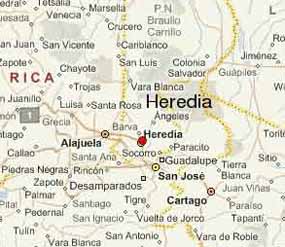Life in CR, Beauty of CR
Monthly Weather Report for San Ramón, Atenas, Nuevo Arenal, Quepos, Near San Isidro de General, & San Rafael de Heredia – February 2015
- By in Blog
You’ll notice that we now show rainfall and temperatures for six towns in Costa Rica. This isn’t weather forecasting. We report after the fact to give you a much better picture of the weather in each of these areas.
You can click on the map to the right to enlarge it and check out the average rainfall for the towns in which you are interested. Remember that the areas shaded in darker blue tend to be higher in elevation and also the places most expats choose to live.
Paul’s San Ramón Observations, Facts, & Tidbits for February:
- Starting late this year, in January, the “Christmas winds” were often gale force (over 50 mph), stopping around March 8th, though it’s still breezy.
- We had one day with a high of only 64°F —that’s the coldest high since we moved to Costa Rica 6 years ago.
- When you live in a mountain climate at 3,000 ft. you may need a light sweater or wrap, socks and long pants. We’ve come to love our mountain climate; it’s refreshing, with no heat or air conditioning needed. Our temps range from 60 °F to 80 °F, 12 months a year.
- We will be heading to Mexico in June to present at the International Living Conference in Cancun.
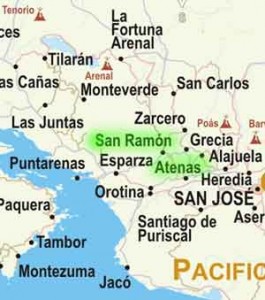
- Total rainfall in 2014 total was 120 inches and 2013’s rainfall was 111 inches in our area of San Ramón.
Lance T’s Atenas Observations, Facts, & Tidbits for February:
- Generally, February in Vista Atenas was characterized by relatively cool morning temperatures in the 60’s and warm dry afternoons with high temperatures in the 80’s. Also, quite windy. The coolest part of every day seemed to occur within the first hour or so after sunrise. (As the sun comes up, the atmosphere “sweats” and the air cools down).
- The hottest daytime high air temperature was 88 °F, but it was accompanied by a dry 22% humidity – resulting in a “feels like” or heat index temperature of only 84.7 °F. In fact, February was so dry that the “feels like” temperature was less than the air temperature high on 22 days out of the month.
- But, unlike February last year, it actually rained on one day – only about 0.07 inches, but measurable nevertheless.
- Total rainfall in 2014 was 73.59 inches and 2013’s rainfall was 63.84 inches in our area of Atenas.
John’s Nuevo Arenal Observations, Facts, & Tidbits for February:
- Saturday, February 28th was the beginning of the Annual Mountain Bike Race/Tour around Lake Arenal. It began in Tilaran Saturday morning, with an overnight stop in La Fortuna and resumed Sunday morning, finishing in Tilaran. There were several thousand participants. The Lake area was full of enthusiastic hotel guests this weekend and a fun place to be.
- We had a record-breaking 185 inches of rain for the year 2014. Total rainfall in 2013 was 164.75 inches in our area of Nuevo Arenal.
Lance M’s Central Pacific Observations, Facts, & Tidbits for February:
- Well, another month has gone by and we are getting closer to the beginning of the rainy season.
- We have been fostering a puppy that was found in the Palm grove just outside our home. She has decided to make a puppy door in our screen door and now runs in and out at will unless we close the big wooden door. We have bought new screen and and a heavy gauge mesh to install on the screen door to prevent this from happening again. Our landlord thought it was a great idea since this is not the first time this has happened. Luckily the little foster puppy has a new home and she will be leaving on Wednesday after her stitches are removed from her stomach were she had been neutered. Paws, the organization we volunteer for, pays to have any animal spayed or neutered and the first two sets of vaccinations. The adoption fee is 5,000 colonies, roughly 10 US dollars.
- We had three days in a row with rain at the beginning of the February with a total of 8.3 inches. Our landlord who has lived here over 40 years told us he can’t remember getting that much rain in February.
- Have at great March from always warm southern zone Costa Rica.
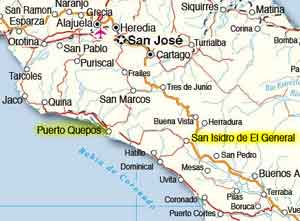
- 2014 rainfall for the Quepos area of the Central Pacific was 73.54 inches (as of February 2014 when I started measuring it for this newsletter).
Gordon’s Quebradas (San Isidro de General) Observations, Facts, & Tidbits for February:
- The coolest morning in February was also the warmest day!
- We had 6 consecutive days of rain, although one was not enough to register in the gauge.
- The gentle breezes make each day very tolerable at this altitude! I have been surprised that on the odd night we have had to add a blanket to the bed.
- The influx of summer birds has been great to see at our feeder, and the increase
in Tucan sightings is only a plus! - The exhibition/rodeo was in San Isidro de El General for 10 days, and we went 2 evenings. Once to see the dancing horses, and then again the next night to the bull fights! Having never been to a bull fight we really enjoyed the evening, complete with some great roping and bull riding. I have to say that life in Costa Rica is pretty darn good!
Steve’s San Rafael de Heredia Observations, Facts, & Tidbits for February:
- Total rainfall to date is 14 inches. Last year it was 2.7 inches. The main difference between dry season and rainy season this year is the direction from which the rain comes: rainy season – rain comes from the west; dry season – rain comes from the east.
- Living here we have learned not to take seemingly little things, like water and light, for granted. Last March the river that provides our water went dry and the water company had to send as many as eight trucks a day to fill their collection/storage tanks. Even then we got just a trickle of water at night and nothing during the day. This year the river is full. For future dry years we now collect rainwater from our roof and store it in tanks. We got mosquitoes breeding in the tanks at first, but have since learned how to prevent this. Our plan is to never be without water again.
- Our front door and carport are on the east side of our house. This is also the windward side during the dry season. Gusts can reach nearly 50 mph (although this year nothing more than 30 mph). We’ve dubbed it the Alaska side of the house (the west side is our Florida side). When we’d get out of the car and make a dash for the door, if we fumbled at all with the key we could get totally soaked from the horizontal rain and our teeth would be chattering by the time we got through the door. So [sound of trumpets blaring], after five years we have enclosed the carport into a garage. You might ask why it took us so long to remedy the situation, and the answer is because there were so many other bad design or poor workmanship features about our house that we had to fix other problems before we got to this one. As the saying goes: better late than never.
- Another thing occurred to me about the difference between living in Costa Rica when I arrived in 1968 and now: no guidebooks. The closest thing to a guidebook was a Pan American World Airways brochure that was eight pages long (as I recall). Poking around the country back then was full of surprises and you missed so many things because you didn’t know they even existed. I found out about Manuel Antonio Beach only because the LACSA plane I was on flew over it and when we landed in Palmar Sur I asked the pilot what the name of the beach was.
Meteorology has been Paul’s lifelong hobby. As a child, he devoured books about the weather and earth sciences vigorously. Later, he took a few college courses in meteorology, and still later, he served as a meteorologist for the U.S. Army in Vietnam. Now, Paul gets to practice his avocation in Costa Rica, albeit on a very small scale with just temperature and rainfall data, probably the two most important factors regarding the weather. He wanted to include weather info on our website to help people decide where to live, although weather is just one of many factors to consider in determining where to relocate. Current weather data is from our current home at about 3,000 ft. elevation and 10 minutes outside the town of San Ramón. Weather data prior to December 2012 is from our previous home at about 4,000 ft. elevation and 10 minutes outside the town of San Ramón.

Our Atenas Weatherman, Lance Turlock
Lance and his wife, Diana, moved to Costa Rica about 2 years ago after living 30+ years in the Lower Mainland of British Columbia (Vancouver and environs). They live in the Central Valley near the town of Atenas and are at an elevation of about 2700 feet. They have no need for air conditioning or heating. Overnight low temperatures are comfortably cool (low 60’s). Daytime highs can be relatively hot (high 80’s, low 90’s), but rarely uncomfortably hot.Lance started to keep track of daily temperatures and rainfall in order to have factual ammunition to help disabuse friends, relatives and acquaintances of any misconception that the weather must be like that of a tropical jungle.
Our Nuevo Arenal Weatherman, John Nicholas
After many visits to Costa Rica, John and Cathy Nicholas moved from New York to Costa Rica in 1991. They chose Arenal for its sacred, majestic beauty, its lush wildlife, its relaxing lifestyle, and its proximity to activities and sites such as the Volcano Arenal and the beaches. They own the B&B, Chalet Nicholas, which has been in operation since 1992. Temperatures and rainfall are measured at Chalet Nicholas which is located at approximately 2,200 ft. elevation and 1 mile west of the town of Nuevo Arenal.
Our Central Pacific (Quepos) Weatherman, Lance Miller
 I was born in a very small town in northwest Iowa and raised on a farm. When I was 18, I joined the service, in which I spent 22 years before retiring in 1990. For the next twenty three years my family and I lived in south central Pennsylvania. After having a stroke in 2012, I was unable to work and that is when my wife and I began talking about retiring. Thanks to your newsletter and a website we found about San Isidro, we began looking at Costa Rica. We came down in March 2013 and looked around for a week. Went home, packed up, and moved here in April. We settled in a small village called Playa Matapalo which is located between Quepos and Dominical. We later moved to Quepos. The word Playa means beach. It is so nice to lie in bed and listen to the ocean. Pura Vida. We will continue the weather info next month.
I was born in a very small town in northwest Iowa and raised on a farm. When I was 18, I joined the service, in which I spent 22 years before retiring in 1990. For the next twenty three years my family and I lived in south central Pennsylvania. After having a stroke in 2012, I was unable to work and that is when my wife and I began talking about retiring. Thanks to your newsletter and a website we found about San Isidro, we began looking at Costa Rica. We came down in March 2013 and looked around for a week. Went home, packed up, and moved here in April. We settled in a small village called Playa Matapalo which is located between Quepos and Dominical. We later moved to Quepos. The word Playa means beach. It is so nice to lie in bed and listen to the ocean. Pura Vida. We will continue the weather info next month.
 Our Quebradas (15 minutes north of San Isidro de General) Weatherman, Gordon Stanley
Our Quebradas (15 minutes north of San Isidro de General) Weatherman, Gordon Stanley
Gordon and his wife Bea moved here from Lloydminster, Alberta, Canada, where he used to track the correlation of the winter hoer frost and the spring/summer rains. After 30+ years as a Purchasing Agent for a retail lumber yard/Homes Manufacturing company, he decided to say “Adios” to the snow and ice. They arrived in Costa Rica Oct. 3, 2014, and live in Quebradas, which is a 15 minute drive North of San Isidro de General, at an elevation of about 3600 feet. There is a stream that runs behind the hill in their back yard, so are “forced” to listen to the sound of running water 24/7. Ahh the tough life! They are totally enjoying their new found retirement freedom in this wonderful land that they discovered thanks to this newsletter.
 Our San Rafael de Heredia Weatherman, Steve Johnson
Our San Rafael de Heredia Weatherman, Steve Johnson
I’m a weather geek and have been recording daily weather data for the last 4 years in Concepcion de San Rafael de Heredia. We live at 5,000 ft. (1,500 meters) elevation, above San Rafael centro on a low ridge that comes off of Cerro Chompipe (between Barva Volcano and los Cerros de Zurqui). We have a 60 mile wide view from Turrialba Volcano east to somewhere around Cerro Turrubares west. I first lived in CR as a Peace Corps volunteer (1968-71), married a tica school teacher, and moved back to Costa Rica in 2009. My wife grew up in downtown San Rafael just three miles away, and the weather is quite different there. I am also an avid gardener and birder.
